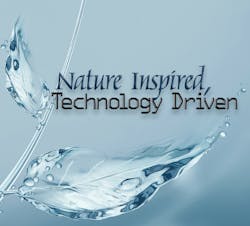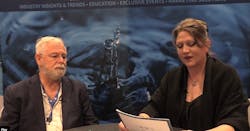New and innovative technology, inspired by natural systems, is set to disrupt the clean water space.
Cape Town. Flint. California. Each are examples of how precious drinking water is, and how faulty systems can affect a large population. According to The New Republic, 5,000 drinking water systems in the United States had health-based violations in 2015, and more than 50 percent were systems that serve 500 people or fewer.
It’s a big issue, and one that continues to attract the attention of engineers, chemists and utility plant managers on a quest to find new and innovative treatment solutions — many of which take cues from the natural world. From plant life to cellular technology, researchers are emulating nature to develop the technology that will solve the world’s water crises.
Here, we’ve gathered up some of the most interesting technology set to disrupt the clean water space.
Scientists at PNNL have created a new family of nanotubes that are composed of peptide-like molecules called peptoids. These nanotubes start out as small droplets that come together to form a cell-membrane-like sheet. Then the sheet folds at one end and zips closed into a tube. Photo courtesy PNNL.
Totally Tube-ular
Hollow nanotubes thousands of times smaller than a strand of human hair could revolutionize water filtration, tissue engineering and other applications. The tubes, designed by a team of scientists at the Department of Energy’s Pacific Northwest National Laboratory (PNNL), were inspired by protein structures called microtubules that live inside cells.
The scientists hope to use hollow microtubules to create a robust water filtration system that would trap salt or other contaminants inside and let pure water flow out. In addition, they want to monitor how stem cells adapt to different environments by studying how the cells change while they grow on these tubes.
But the researchers can’t use microtubules themselves for these projects because they are susceptible to temperature changes and microbes. “You don’t want to have a filter that can be eaten by bacteria,” said Chun-Long Chen, the materials chemist who conceived of and directed the project.
“The structure of the cell is so beautiful,” he said. “We wanted to create a synthetic system that mimics the microtubule structure and is stable enough for a variety of technical applications.”
The synthetic version uses protein-like molecules called peptoids. Like proteins, peptoids are composed of a repeating pattern of building blocks with slight variations, but peptoids are more stable.
These new nanotubes form in a unique way. From the groups findings: “First, small peptoid particles come together to form a sheet. Then the sheet closes at one end and rolls into a seamless tube.” The group found it could control a tube’s size, diameter, thickness and stiffness by adjusting the tube composition or changing the acidity of the solution.
The findings are promising, according to Chen. “Nature has offered us all kinds of beautiful examples,” he said. “Fish can take in water from the sea without having to worry about high salt conditions. If we could mimic this behavior by building artificial cell membranes containing these nanotubes, we could solve some of the big problems facing our world today.”
Slick Harvesting
Inspired by the way water is collected by living organisms, scientists at The University of Texas at Dallas and Penn State University have created and tested a combination of materials that can do the same thing, but faster.
This image shows a comparison of water harvesting performance of SRS vs. other state-of-the-art liquid repellent surfaces. The left panel is a directional slippery rough surface (SRS, this study), the middle panel is a slippery liquid-infused porous surface (SLIPS) and the right panel is a superhydrophobic surface. Photo courtesy Xianming Dai/Nan Sun/Jing Wang/Tak-Sing Wong, Penn State.
“With an estimated 4 billion people living in a situation of water scarcity during at least some part of the year, an inexpensive method for harvesting water from water vapor or from fog droplets in air could have enormous practical applications, and will help alleviate the water scarcity issues in many regions of the world,” said the project’s leader, Tak-Sing Wong, who is the Wormley Family Early Career Professor in Engineering and assistant professor of mechanical engineering at Penn State.
Wong’s team examined textures on rice leaves and pitcher plants — both of which can trap and direct water droplets — and engineered a surface that they then infused with a liquid lubricant that attracts water. Using their material, they were able to capture water droplets from fog and air vapor, and direct them quickly into reservoirs via lubricated microgrooves.
The researchers’ hydrophilic directional slippery rough surfaces (SRS) “combined the slippery interface of a pitcher plant with the surface architecture of a rice leaf, which has micro/nanoscale directional grooves on its surface that allow water to be removed very easily in one direction but not the other,” explained Simon Dai, an assistant professor at UT Dallas.
SRS can be optimized and adjusted to fit specific applications in a broad range of industries, including air conditioning, power generation, desalination and water harvesting in arid regions, according to the researchers. If the material is produced at scale, the team estimates it can collect over 120 liters of water per square meter (26.52 gallons per square yard) of the surface per day. That number could grow if the material can be further optimized. The researchers have filed a patent on the technology.
“We are hopeful that these surfaces can be scaled up or down depending upon need,” Dai said. “Next steps would include improving water harvesting capabilities at lower humidity ranges.”
Clean with Green
Researchers at the RIKEN Center for Sustainable Resource Science (CSRS) in Japan are using moss to remove lead and other metals from water. Phytoremediation is a method that uses photosynthesizing organisms to clean up soil or water contamination.
“We found that moss can function as an excellent lead absorbent when in the protonema stage of development,” said first author Misao Itouga.
In particular, the moss Funaria hygrometrica, which is known to grow well in sites contaminated with metals like copper, zinc, and lead, may have other uses.
Itouga and his team first placed the moss protonema in a lead-based solution for 22 hours. Within the moss protonema cells, more than 85 percent of the lead had accumulated in the cell walls, with smaller amounts being found in organelle membranes and inside the chloroplasts where photosynthesis occurs.
The team found that the cell walls of the moss absorbed lead even after being removed from living moss. According to a press release, “further analysis with two-dimensional nuclear magnetic resonance indicated that polygalacturonic acid in the cell walls was responsible for absorbing the lead,” and “is a useful biomaterial for recovering lead from aqueous solutions.”
While the researchers initially hope to treat wastewater from mining and chemical industries, the technology could be used for indirect potable reuse programs to boost water supply in the future.
Cells treated with 0.1 millimolar (mM) PbCl2. This view focuses on the cell wall (cw). Absorbed lead (Pb) can be seen at the black arrows. The upper box is a close-up of the lower black box on the cell wall. Photo courtesy RIKEN.
California Dreaming
As a state that has been continually plagued by droughts, California is poised to tackle the water supply issue head-on. Seven California colleges were recently awarded grants to fund proposals to develop new water conservation and supply technologies as part of the 2018 Southern California World Water Forum. The $10,000 grants were awarded to projects that “propose and explore innovative ways to provide safe water to communities in California and around the world.”
“Our California colleges and universities are fertile ground to develop the next generation of sustainable technologies,” said Jeffrey Kightlinger, general manager of the Metropolitan Water District of Southern California, one of the World Water Forum co-sponsors. “These ideas help ensure water reliability not only in local communities where they are greatly needed but also across the globe.”
Through the program, grant winners must design a project or prototype that will contribute to a more sustainable water future, including developing a business plan and providing evidence it could become fully sustainable.
Among this year’s selected proposals is one from the University of California at Davis, where researchers will further develop and test a solar-powered water treatment system that could be used in rural, underserved communities. A San Diego State University project to find a lower cost and less energy-intensive approach to seawater desalination will explore using low-grade waste heat to convert seawater to vapor and then condense it to form pure water.
Solving the global water crisis is an ambitious pursuit and seemingly insurmountable challenge, but innovations like these and others give hope that a solution may not lie too far in the future. WW
About the Author: Alanna Maya is the assistant editor for WaterWorld and Industrial WaterWorld. Email her at [email protected].







